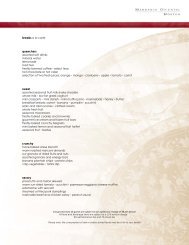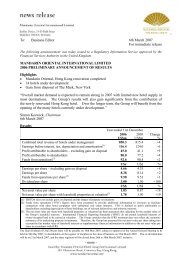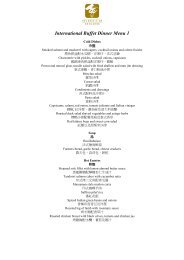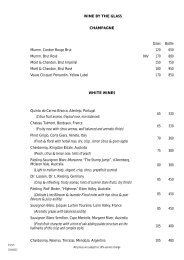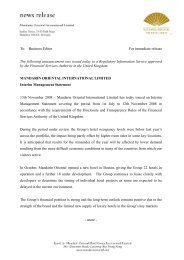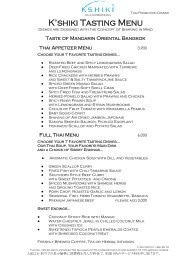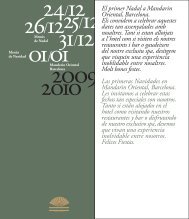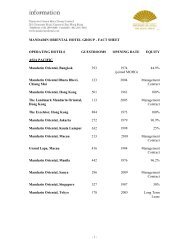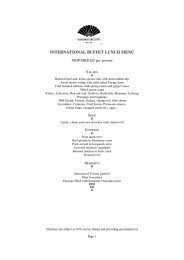Annual Report 2011 - Mandarin Oriental Hotel Group
Annual Report 2011 - Mandarin Oriental Hotel Group
Annual Report 2011 - Mandarin Oriental Hotel Group
Create successful ePaper yourself
Turn your PDF publications into a flip-book with our unique Google optimized e-Paper software.
34 <strong>Mandarin</strong> <strong>Oriental</strong> International Limited<br />
Principal Accounting Policies Continued<br />
A Basis of preparation continued<br />
In addition to the above, the IASB has also issued IFRS 9 ‘Financial Instruments’ (2009) and IFRS 9 (2010) which<br />
are effective from 1st January 2013. However, in August <strong>2011</strong>, the IASB issued an exposure draft that proposes to<br />
delay the effective date of IFRS 9, ‘Financial Instruments’, to annual periods beginning on or after 1st January 2015.<br />
The original effective date was for annual periods beginning on or after 1st January 2013. This proposal is a result<br />
of the extension of the IASB’s timeline for completing the remaining phases (for example, impairment and hedge<br />
accounting) of its project to replace IAS 39 beyond June <strong>2011</strong>. IFRS 9 (2009) is the first standard issued as part of a<br />
wider project to replace IAS 39. It retains but simplifies the mixed measurement model and establishes two primary<br />
measurement categories for financial assets: amortized cost and fair value. The basis of classification depends on the<br />
entity’s business model and the contractual cash flow characteristics of the financial asset. The guidance in IAS 39 on<br />
impairment of financial assets and hedge accounting continues to apply. IFRS 9 (2010) adds the requirements related<br />
to the classification and measurement of financial liabilities, and derecognition of financial assets and liabilities, to the<br />
version issued in November 2009. It also includes those paragraphs of IAS 39 dealing with how to measure fair value<br />
and accounting for derivatives embedded in a contract that contains a host that is not a financial asset, as well as<br />
the requirements of IFRIC 9 ‘Remeasurement of Embedded Derivatives’. The <strong>Group</strong> will apply the standard from<br />
1st January 2015.<br />
The principal operating subsidiaries, associates and joint ventures have different functional currencies in line with the<br />
economic environments of the locations in which they operate. The functional currency of the Company is United<br />
States dollars. The consolidated financial statements are presented in United States dollars.<br />
The <strong>Group</strong>’s reportable segments are set out in note 1.<br />
Certain comparative figures have been reclassified to conform with current year presentation.<br />
B Basis of consolidation<br />
i) The consolidated financial statements include the financial statements of the Company, its subsidiaries, and its<br />
associates and joint ventures.<br />
ii) Subsidiaries are entities over which the <strong>Group</strong> has the power to govern the financial and operating policies. The<br />
purchase method of accounting is used to account for the acquisition of subsidiaries by the <strong>Group</strong>. The cost of an<br />
acquisition include the fair value at the acquisition date of any contingent consideration. In a business combination<br />
achieved in stages, the <strong>Group</strong> remeasures its previously held interest in the acquiree at its acquisition-date fair value<br />
and recognized the resulting gain or loss in profit and loss. Changes in a parent’s ownership interest in a subsidiary<br />
that do not result in the loss of control are accounted for as equity transactions. When control over a previous<br />
subsidiary is lost, any remaining interest in the entity is remeasured at fair value and the resulting gain or loss is<br />
recognized in profit and loss.<br />
All material intercompany transactions, balances and unrealized surpluses and deficits on transactions between<br />
<strong>Group</strong> companies have been eliminated. The cost of and related income arising from shares held in the Company<br />
by subsidiaries are eliminated from shareholders’ funds and non-controlling interests, and profit respectively.



